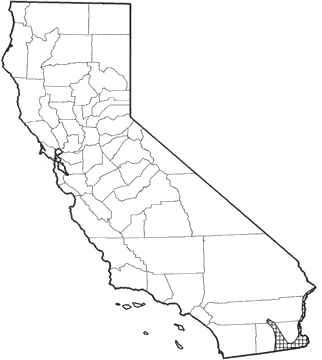
Hispid Cotton Rat
Distribution, Abundance, and Seasonality
In California, occurs only along the Colorado River and in the Imperial Valley. Establishment of cotton rats in the Imperial Valley apparently was in response to agricultural irrigation practices (Dixon 1922). Most common in grassland and cropland habitats near water (Fleharty and Mares 1973, Kaufman and Fleharty 1974), including grass-forb understories in early successional stages of other habitats (McClenaghan and Gaines 1978). Also occurs in overgrown clearings, and herbaceous borders of fields and brushy areas (Hall and Dalquest 1963).

Range Map
Specific Habitat Requirements
Feeding: Feeds mainly on grasses, eating insects seasonally. Food is not stored. Runways are made through dense herbaceous growth, and are similar in appearance to vole runways but much larger. Sometimes feeds on sugar beets, citrus, and other crops.
Cover: Tall, dense grass is preferred.
Reproduction: Nests of woven grass are constructed either in burrows or on the surface (Baar et al. 1974).
Water: No data found, but probably requires free water.
Pattern: Grasslands, overgrown clearings and herbaceous borders of fields, and brushy areas are preferred.
Species Life History
Activity Patterns: Both nocturnal and diurnal, with bimodal nocturnal activity pattern (Kilduff and Dube 1979). Active yearlong.
Seasonal Movements / Migration: None.
Home Range: Home range averaged 0.35 to 0.39 ha (0.86 to 0.96 ac) for males, and 0.22 ha (0.54 ac) for females (Fleharty and Mares 1973, Layne 1974). Males tend to have larger home ranges than females, and adults have larger home ranges than juveniles (Layne 1974, Cameron et al. 1979). Maximum densities occur in the fall (range 14 to 69/ha or 5.7 to 28/ac), and minimum densities are reported for the winter or summer (range 0.5 to 25/ha or 0.20 to 10/ac).
Territory: Solitary, with prolonged male-female contact only in the breeding season (Liu 1971).
Reproduction: In Kansas, breeding season is from early spring to late fall with a peak in August (Bancroft 1969). In Texas, breeding peaks in the fall and spring (Cameron 1977). No data found for California populations. Solitary nester. Gestation period is 27 days. Litter size average 7.3 young in Kansas, and 3.4 young in Texas (Kilgore 1970). Litter size range from 1-15 (Cameron and Spencer 1981). Weaning occurs at 10-15 days of age. Males can breed at 2-3 mo of age. Females are sexually mature at 30-50 days of age (Meyer and Meyer 1944).
Niche: A large rodent (100-225 g, 3-9 oz) of herbaceous habitats. Avian predators appeared to be important in regulating densities, whereas mammalian predators (foxes, coyotes, bobcats, mustelids, house cats) were incidental and density-independent in effect (Schnell 1968). Competitors include other cricetid rodents, especially microtines and Mus musculus. Sigmodon appears behaviorally dominant over Microtus and Reithrodontomys (Baker 1971, Cameron 1977). Parasitized by trematodes, cestodes, nematodes, and fleas (Mollhagan 1978). Diseases transmissible to humans include rabies, Chagas' disease, and Venezuelan equine encephalomyelitis (World Health Organization 1974).
Sources & References
California Department of Fish and Game, 1999.
California's Wildlife, Sacramento, CA.
Written by: P. Brylski, reviewed by: H. Shellhammer, edited by: R. Duke
Baar, S. L., E. D. Fleharty, and M. F. Artman. 1974. Utilization of deep burrows and nests by cotton rats in west-central Kansas. Southwest. Nat. 19:440-444. Baker, R. H. 1971. Nutritional strategies of myomorph rodents in North American grasslands. J. Mammal. 52:800-805. Bancroft, W. L. 1969. Notes on reproduction of three rodents of Douglas County, Kansas. Trans. Kans. Acad. Sci. 72:67-69. Cameron, G. N. 1977. Experimental species removal: demographic responses by Sigmodon hispidus and Reithrodontomys fulvescens. J. Mammal. 58:488-506. Cameron, G. N., and S. R. Spencer. 1981. Sigmodon hispidus. Mammal. Species No. 158. 9pp. Cameron, G. N., W. B. Kincaid, and B. A. Carnes. 1979. Daily movement patterns of Sigmodon hispidus. Southwest. Nat. 24:63-70. Dixon, J. 1922. Rodents and reclamation in the Imperial Valley. J. Mammal. 3:136-146. Fleharty, E. D., and M. A. Mares. 1973. Habitat preference and spatial relations of Sigmodon hispidus on a remnant prairie in west-central Kansas. Southwest. Nat. 18:21-29. Hall, E. R., and W. W. Dalquest. 1963. The mammals of Veracruz. Univ. Kans. Publ., Mus. Nat. hist. 14:165-362. Kaufman, D. W., and E. D. Fleharty. 1974. Habitat selection by nine species of rodents in north-central Kansas. Southwest. Nat. 19:443-452. Kilduff, T. S., and M. G. Dube. 1979. The effects of seasonal photoperiods on activity of cotton rats and rice rats. J. Mammal. 60:169-176. Kilgore, D. L., Jr. 1970. The effect of northward dispersal on growth rate of young, size of young at birth, and litter size in Sigmodon hispidus. Am. Midl. Nat. 84:510-520. Layne, J. N. 1974. Ecology of small mammals in flatwoods habitat in north-central Florida, with emphasis on the cotton rat (Sigmodon hispidus). Am. Mus. Novitates No. 2544. 48pp. Liu, E. S. 1971. The ethology of the cotton rat, Sigmodon hispidus. M.S. Thesis, Univ. Florida, Gainesville. 85pp. McClenaghan, L. R., Jr., and M. S. Gaines. 1978. Reproduction in marginal populations of the hispid cotton rat (Sigmodon hispidus) in northern Kansas. Univ. Kans. Mus. Nat. Hist. Publ. No. 74. 16pp. Meyer, B. J., and R. K. Meyer. 1944. Growth and reproduction of the cotton rat, Sigmodon hispidus, under laboratory conditions. J. Mammal. 25:107-129. Mollhagan, T. 1978. Habitat influence on helminth parasitism of the cotton rat in western Texas, with remarks on some of the parasites. Southwest. Nat. 23:401-407. Schnell, J. H. 1968. The limiting effects of natural predation on experimental cotton rat populations. J. Wildl. Manage. 32:698-711. World Health Organizaton. 1974. Ecology and control of rodents of public health importance. World Health Organ. Tech. Rep. Ser. 533. 42pp.
California Animal Facts | California's Wildlife